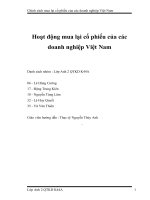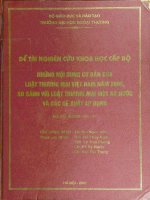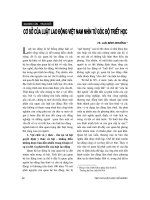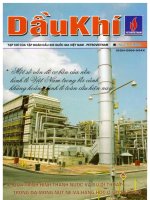Cô lập của SESQUITERPENOIDS từ thân rễ của CURCUMA AROMATICA SALISB Việt Nam
Bạn đang xem bản rút gọn của tài liệu. Xem và tải ngay bản đầy đủ của tài liệu tại đây (121.18 KB, 5 trang )
96
Journal of Chemistry, Vol. 38, No. 4, P. 96 - 99, 2000
ISOLATION OF SESQUITERPENOIDS FROM THE RHIROMES OF
VIETNAMESE CURCUMA AROMATICA SALISB.
Received 5-6-2000
Phan Minh Giang, Phan Tong Son
College of Natural Science, Vietnam National University, Hanoi
Summary
The petroleum ether extract from the rhizomes of Curcuma aromatica Salisb. growing in
Vietnam was subjected to repeated flash chromatography on silica gel to give six oxygenated
sesquiterpenes furanodiene (1), furanodienone (2), curzerenone (3), germacrone (4),
curcumenone (5) and zederone (6) together with three sesquiterpene hydrocarbons
-humulene,
-selinene,
-selinene.
INTRODUCTION
The rhizomes of C. aromatica Salisb.,
Zingiberaceae, have been used medicinally in
China, Japan and Southeast Asia [1]. As it
contains bioactive principles, the chemical
composition of C. aromatica have been
investigated extensively and it is recognized to
be a rich source of terpenoids. However, these
investigations were focused on the plant
growing in India, China and Japan [2-12], little
is known about that growing in Vietnam.
Hitherto, only the essential oil from C.
aromatica rhizomes collected in Northern
Vietnam has been analysed [13, 14].
Curzerenone, germacrone as the major
constituents together with minor sesquiterpene
hydrocarbons and monoterpenoids were
identified [14].
In a previous paper [15], we reported the
results of our investigation on the composition
of the extracts from the rhizomes of C.
aromatica Salisb. growing in Vietnam by
means of GC, GC-MS and NMR methods. This
paper goes into details of the isolation and
identification of the sesquiterpenoid
constituents.
RESULTS AND DISCUSSION
Repeated chromatography on silica gel of
the petroleum ether soluble-fraction of an
EtOH extract of C. aromatica rhizomes
gave three sesquiterpene hydrocarbons (-
humulene, -selinene and -selinene) and six
oxygenated sesquiterpenes (furanodiene (1),
furanodienone (2), curzerenone (3), germacrone
(4), curcumenone (5) and zederone (6)). Of
these, the hydrocarbons were identified by
comparison of their MS and
1
H-NMR spectra
with those of authentic samples together with
the relative retention indices (RRI) measured
on GC capillary column CP Sil5 CB.
Furanodiene (1) [16], furanodienone (2)
[17] and curzerenone (3) [18] were first found
in C. zedoaria, Zingiberaceae. We also isolated
the interesting sesquiterpenoid germacrone (4)
which also was found in many Curcuma
species. The spectral data (MS,
1
H- and
13
C-
NMR) of the compounds 1 - 4 are in full
agreement with those isolated by us from C. aff.
aeruginosa Roxb., Zingiberaceae [19]. Of the
two main constituents 3 and 4 of this extract
(GC: together 30.7%), curzerenone (3) has been
97
found to be active against Mycobacterium tuberculosis H
3
7
RV [14].
Curcumenone (5) was isolated as colorless oil from a more polar fraction; 5 has also been
isolated from C. zedoaria [20], C. longa [21] and C. aromatica of Japan [3]. Biogenetically, this
seco-guaiane-type dicetone may be formed from germacrone via a guaiane-type cationic
intermediate [20].
The IR spectrum of compound 6 (C
1
5
H
1
8
O
3
,
from HR-MS) exhibited absorption bands due
to an ,-unsaturated cetone (1674 cm
-1
), and
an epoxide ring (846 cm
-1
), no hydroxyl or
other carbonyl absorption bands were observed.
The
13
C-NMR and DEPT spectra of 6 indicated
the presence of 15 C, including a cetonic
carbonyl [ 192.1 ppm (s)], two oxygenated
carbons [ 63.9 (s) and 66.5 ppm (d)], 6
olefinic carbons (4s and 2d), three methylene
and three methyl groups. The
1
H-NMR
spectrum showed characteristic signals for a
trisubstituted furan ring [ 7.06 (s), -H; 2.09
ppm (s), -CH
3
], and a vinylic proton [5.46
ppm (dd, J = 4 Hz, 12 Hz)]. The chemical shift
and coupling constants of this vinylic proton
suggested that the cetonic carbonyl could only
be in conjugation with the furan ring. The
presence of an epoxy function was supported by
the signals at 1.32 (s, 4-Me) and 3.79 (s, H-5)
in
1
H-NMR spectrum as well as two carbon
signals at 63.9 (s) and 66.5 (d) in
13
C-NMR
spectrum. The other major feature of the
1
H-
NMR spectrum of 6 was an AB system (2H)
with doublets centered at 3.66 and 3.73 ppm
(J = 16 Hz) (2 H-9). Thus on the basis of
spectral data, a furanogermacrane skeleton for
6 was suggested. The complete
1
H-
1
H COSY
and HMQC spectral data confirmed the
structure of zederone (6). Zederone was
reported to be found in C. zedoaria [22, 23].
The relative stereochemistry of 6 was
established by a NOESY experiment to be
identical with the revised stereochemical
structure proposed by I. Kitagawa et al. [24].
Figure 1: Important NOESY interactions of 6
EXPERIMENTAL
General procedures
All melting points are uncorrected. Optical
rotation was obtained on a Polartronic D
CH
3
H
CH
3
O
O
H
H
H
H
H
H
H
O
10
6
9
8
7
11
12
13
15
14
5
4
3
2
1
O
O
O
6
5
13
12
11
14
4
3
2
1
10
9
8
7
15
3
O
O
2
1
O
O
O
O
O
O
H
4 5 6
98
(Schmidt + Haensch).
1
H-NMR (CDCl
3
):
Bruker AM 400.
13
C-NMR (CDCl
3
): Bruker AC
200 with DEPT programme. For zederone (6)
all NMR spectra were taken on a Bruker AMX
600. IR (CCl
4
): Perkin-Elmer 881. HR-MS:
Finigan MAT 95 SQ. GC-EIMS: Hewlett-
Packard 5890 II with a HP-1 column (25 m x
0.2 mm i.d., film thickness 0.5 µm) combined
with MSD HP 5971A, carrier gas He. GC:
Packard 439 with a CP Sil 5 CB column (25 m x
0.25 mm i.d., film thickness 0.39 µm); carrier
gas: N
2
; detector: FID; plotter: Shimadzu C-
R6A Chromatopack; temperature programme:
60 - 220
o
C, 5
o
C/min; injector temperature:
270
o
C; detector temperature: 300
o
C. FC: silica
gel ICN Biomedicals (32-63 µm). TLC: DC-
Alufolien 60 F
254
No. (Merck 5554).
Visualisation: UV light 254 nm, anisalde-
hyde/H
2
SO
4
.
Extraction and Isolation
The dried rhizomes of C. aromatica (1kg)
collected in Socson, Hanoi (Vietnam) were
powdered and extracted with EtOH 96% by
percolation at room temperature. The combined
extract was partially concentrated under
reduced pressure, then dissolved in distilled
water, and partitioned with petroleum ether
(PE, b.p. 30 - 60
o
C) and EtOAc successively to
afford PE (15.9 g) and EtOAc (17.9 g)
fractions. The PE fraction (3 g) was subjected
to FC (applied pressure ~ 0.2 mbar) eluted with
pentane-EtOAc (95 : 5) to give 6 fractions.
Fraction 1 contained 33mg -selinene and -
selinene. 171 mg fraction 2 was rechromato-
graphed on AgNO
3
-impregnated silica gel
using pentane as eluent to give 34 mg -
humulene. Repeated FC of 515 mg fraction 3
eluted with PE-diethyl ether (4:1) afforded
furanodiene (1) (52 mg), curzerenone (3) (43
mg) and germacrone (4) (63 mg). Fractions 4
and 5 were concentrated under reduced
pressure and further purified by solid phase
extraction using silica gel Waters cartridges to
give furanodienone (2) in the yields of 298 mg
and 424 mg, respectively. Fraction 6 was
repeatedly chromatographed using pentane-
diethyl ether (7 : 3) to yield 83 mg
curcumenone (5) (GC: 83%) and 100mg
crystalline zederone (6) (GC: 100%).
Furanodiene (1), furanodienone (2),
curzerenone (3) and germacrone (4) were
obtained as colorless oils. For RRI
Sil5
, MS,
1
H-
and
13
C-NMR, see reference 19.
Curcumenone (3):
Colorless oil. RRI
S
il5
: 1802.
HR-MS: 234.1617 (C
1
5
H
2
2
O
2
).
1
H-NMR: 0.40 (1H, ddd, J = 4.4 Hz, 7.3
Hz, 7.3 Hz, H-1), 0.64 (1H, m, H-5), 1.08 (3H,
s, 10-CH
3
), 1.54 - 1.62 (2H, m, 2 H-2), 1.75
(3H, s, 11-CH
3
), 2.06 (3H, s, 11-CH
3
), 2.10
(3H, s, 4-CH
3
), 2.44 (2H, dd, J = 7 Hz, 7 Hz, 2
H-3), 2.52 (1H) and 2.98 (1H), AB system, J =
16 Hz (2 H-9), 2.70 - 2.80 (2H, m, 2 H-6).
13
C-NMR: 24.0 (d, C-1), 23.3 (t, C-2), 43.7
(t, C-3), 208.8 (s, C=O, C-4), 23.3 (d, C-5), 28.1 (t,
C-6), 127.9 (s, C-7), 201.7 (s, C=O, C-8), 48.7 (t,
C-9), 19.9 (s, C-10), 147.5 (s, C-11), 23.3 (q, C-
12), 23.3 (q, C-13), 29.9 (q, C-14), 18.9 (q, C-15).
Zederone (6):
Colorless needles. mp 149-150
o
C. RRI
Sil5
:
1961.
[]
D
31
+290
o
(c 1.14, CHCl
3
).
IR:
max
cm
-1
1674, 1558, 1428, 1235, 1108,
1022, 931, 846.
HR-MS: 246.1256 (C
15
H
18
O
3
).
GC-MS: m/z (%) 246 (35), 231 (4), 213 (5),
188 (29), 175 (100), 161 (38), 147 (22), 133 (15),
122 (25), 119 (74), 105 (24), 91 (29), 77 (23), 65
(16), 53 (12).
1
H-NMR (with COSY): 1.27 (1H, ddd, J = 4
Hz, 13.0 Hz, 13.5 Hz, H-3), 1.32 (3H, s, 4-CH
3
),
1.58 (3H, s, 10-CH
3
), 2.09 (3H, s br, 11-CH
3
),
2.21 (1H, d br, J = 13.5 Hz, H-2), 2.28 (1H, ddd,
J = 3.5 Hz, 3.5 Hz, 13.0 Hz, H-3), 2.50 (1H,
dddd, J = 3,5 Hz, 12.0 Hz, 13.5 Hz, 13.5 Hz, H-
2), 3.66 (1H) and 3.73 (1H), AB system, J = 16
Hz (2 H-9), 3.79 (1H, s, H-5), 5.46 (1H, dd br, J =
4 Hz, 12 Hz, H-1), 7.06 (1H, s br, H-12).
13
C-NMR (with HMQC): 131.1 (d, C-1),
24.6 (t, C-2), 37.9 (t, C-3), 63.9 (s, C-4), 66.5
99
(d, C-5), 192.1 (s, C=O, C-6), 122.1 (s); 131.0
(s) (C-7; C-10), 157.0 (s, C-8), 41.8 (t, C-9),
123.2 (s, C-11), 138.0 (d, C-12), 10.2 (q, C-13),
15.7 (q, C-14), 15.1 (q, C-15).
Acknowlegements
The authors are grateful to the
International Foundation for Science (IFS,
Grant No. F/2841-1) for the financial support.
We thank Prof. Dr. Peter Weyerstahl,
Technische Universitat Berlin, Germany, for
the GC-MS and NMR spectra.
REFERENCES
1. Vo Van Chi. Dictionary of Vietnamese
medicinal plants, Publishing House
Medicine, Ho Chi Minh City (1997).
2. C. A. N. Catalan, A. Bardon, J. A. Retamar,
E. G. Gros, J. Verghese, M. T. Joy. Flavour
Fragrance J., 4 (1), 25 - 30 (1989).
3. M. Kuroyanagi, A. Ueno, K. Ujiie, S. Sato.
Chem. Pharm. Bull., 35 (1), 53 - 59 (1987).
4. M. Kuroyanagi, K. Ujiie, A. Ueno, S. Sato.
Tennen Yuki Kagobutsu Toronkai Koen
Yoshishu, 29, 528 - 535 (1987); see Chem.
Abstr. 109, 190589p (1988).
5. M. Kuroyanagi, A. Ueno, K. Koyama and
S. Natori. Chem. Pharm. Bull., 38 (1), 55 -
58 (1990).
6. F. D. Carter, F. C. Copp, B. S. Rao, J. L.
Simonsen and K. S. Subramaniam. J. Chem.
Soc., 1939, 1504 - 1509.
7. A. Gopalam, M. J. Ratnambal. Indian
Perfum., 31 (3), 245 - 248 (1987).
8. Y. T. Guo, X. K. Chu, Y. R. Chen, X. Y.
Wu, G. Chen, X. R. Lu. Yao Hsueh Hsueh
Pao, 15 (4), 251 - 252 (1980); see Chem.
Abstr. 93, 235081m (1980).
9. J. T. Rao, S. S. Nigam. Flavour Ind., 5 (9-
10), 234 - 236 (1974).
10. B. S. Rao, V. P. Shintre and J. L. Simonsen.
J. Indian Inst. Sci., 9A, 140 - 144 (1926);
see Chem. Abstr. 21, 798
8
(1927).
11. B. S. Rao and J. L. Simonsen. J. Chem. Soc.,
2496 - 2505 (1939).
12. J. H. Zwaving, R. Bos. Flavour Fragrance
J., 7 (1), 19 - 22 (1992).
13. Phan Tong Son, Van Ngoc Huong, Nguyen
Van Dau, Luong Si Binh, M. A. Posthumus.
J. of Chemistry (Vietnam), 27 (3), 18 - 19
(1989).
14. Luong Si Binh. Ph.D. Thesis, Hanoi
University (1987).
15. Phan Minh Giang, Van Ngoc Huong, Phan
Tong Son. J. of Chemistry (Vietnam), 37
(1), 57-59 (1999).
16. H. Hikino, K. Agatsuma, T. Takemoto.
Tetrahedron Lett., 8, 931 - 933 (1968).
17. H. Hikino, C. Konno, K. Agatsuma, and T.
Takemoto, I. Horibe, K. Tori, M. Ueyma, and
Ken'ichi Takeda. J. Chem. Soc., Perkin Trans.
I, 1975 (5), 478 - 484.
18. H. Hikino, K. Agatsuma, T. Takemoto.
Tetrahedron Lett., 24, 2855 - 2858 (1968).
19. Phan Minh Giang, Van Ngoc Huong, Phan
Tong Son. J. of Chemistry (Vietnam), 36
(3), 67 - 72 (1998).
20. Y. Shiobara, Y. Asakawa, M. Kodama, K.
Yasuda and T. Takemoto. Phytochemistry,
24 (11), 2629 - 2633 (1985).
21. M. Ohshiro, M. Kuroyanagi and A. Ueno,
Phytochemistry, 29(7), 2201 - 2205 (1990).
22. H. Hikino, H. Takahashi, Y. Sakurai, T.
Takemoto, N. S. Bhacca. Chem. Pharm.
Bull., 14 (5), 850 - 851 (1966).
23. H. Hikino, K. Tori, I. Horibe, and K.
Kuriyama. J. Chem. Soc. (C), 1971, 688 -
691.
24. H. Shibuya, Y. Hamamoto, Y. Cai, and I.
Kitagawa. Chem. Pharm. Bull., 35 (2), 924-
927 (1987).
100









